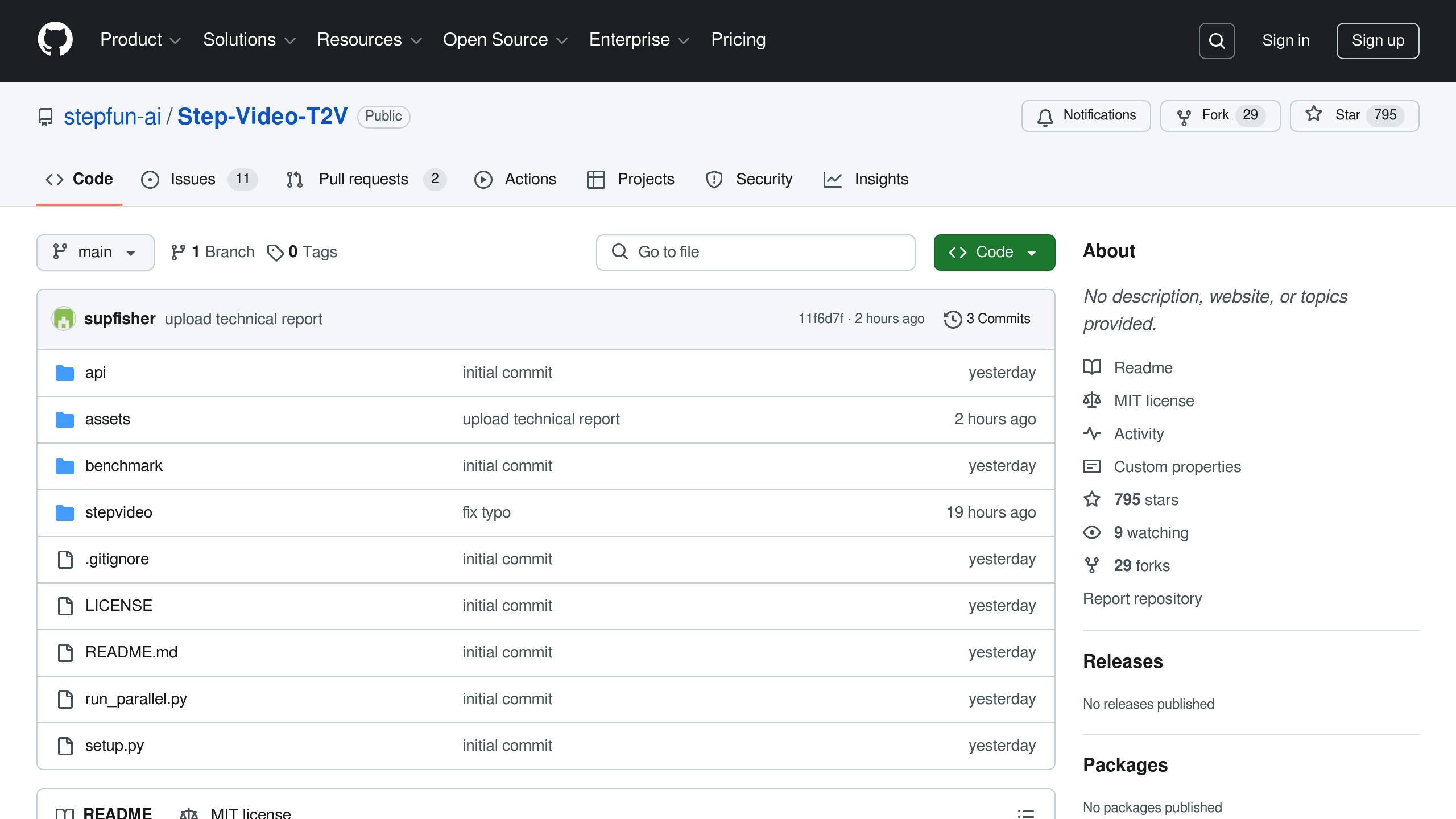AI video generation just got more accessible. Step-Video-T2V, a 30 billion-parameter open-source model, challenges Google’s proprietary Veo 2 by offering high-quality video creation tools to everyone. Unlike Veo 2, which limits public use to 720p and short clips, Step-Video-T2V provides 544×992 resolution videos and supports up to 204 frames, all within an open framework.
Key Features:
- Step-Video-T2V: Open-source, Video-VAE compression, bilingual (English/Chinese), 204-frame limit, 544×992 resolution.
- Google Veo 2: Proprietary, physics-aware realism, supports 4K resolution, up to 60 seconds, enterprise-grade tools.
Quick Comparison:
| Feature | Step-Video-T2V | Google Veo 2 |
|---|---|---|
| Accessibility | Open-source | Proprietary |
| Resolution | 544×992 | Up to 4K |
| Frame Length | 204 frames | Up to 60 seconds |
| Language Support | English, Chinese | Multiple (undisclosed) |
| Customization | Self-hosted options | Tied to Google tools |
| Use Cases | Research, education | Professional-grade |
Step-Video-T2V’s open approach fosters collaboration and transparency, making it ideal for researchers and developers. In contrast, Veo 2 focuses on high-end simulations like fluid dynamics and facial realism. Both models excel in their own ways, but Step-Video-T2V’s open design is reshaping the industry by making AI video generation more accessible and versatile
Core Technology Comparison
Step-Video-T2V and Veo 2 take different approaches in their core designs. Step-Video-T2V employs Video-VAE compression and a cascaded training process, while Veo 2 uses undisclosed, physics-aware systems aimed at creating lifelike simulations . These differences influence their usability and functionality, as outlined in the table below:
| Feature | Step-Video-T2V | Google Veo 2 |
|---|---|---|
| Compression Method | Video-VAE with 16×16 spatial, 8x temporal | Proprietary |
| Language Support | English and Chinese | Multiple (proprietary) |
The open-source nature of Step-Video-T2V contrasts sharply with the closed, proprietary structure of Google Veo 2. Step-Video-T2V’s fully transparent architecture allows for community-driven verification and updates, while Veo 2’s physics-aware design focuses on advanced simulations, including fluid dynamics, cloth behavior, and facial expressions .
Step-Video-T2V’s cascaded training pipeline not only supports community contributions but also addresses a variety of user needs, thanks to its bilingual support. This openness is a hallmark of its design, making it more accessible to a diverse audience. In contrast, Veo 2 leans toward professional-grade tools and cinematic controls, catering to users looking for high-end creative capabilities .
When it comes to ensuring content integrity, the two models also diverge. Google Veo 2 uses SynthID, a proprietary watermarking system designed to verify content origins . On the other hand, Step-Video-T2V relies on the transparency of its training data and the collaborative oversight of its user community, staying true to the principles of open-source development .
Quality and Speed Analysis
Both models take different approaches to optimization but deliver strong performance. Step-Video-T2V creates videos at a resolution of 544×992 (204 frames), while Google Veo 2 outputs 4K videos up to one minute in length .
Here’s how they compare:
| Performance Metric | Step-Video-T2V | Google Veo 2 |
|---|---|---|
| Maximum Resolution | 544×992 | Up to 4K |
| Frame Length | 204 frames | Up to 60 seconds |
| GPU Utilization | >99.0% training efficiency | Not disclosed |
Step-Video-T2V achieves over 99% GPU training efficiency , highlighting its ability to manage resources effectively. Both models excel at handling motion, with Step-Video-T2V minimizing artifacts through its video-based DPO technique .
The open-source Step-Video-T2V model has been thoroughly evaluated using the Step-Video-T2V-Eval benchmark, which includes 128 prompts across 11 categories . It performs consistently well across various scenarios, from landscapes to human interactions.
This comparison underscores how open-source models like Step-Video-T2V are now performing at a competitive level, even when stacked against Veo 2’s higher resolution capabilities.
sbb-itb-5392f3d
Market and Community Impact
Step-Video-T2V isn’t just about its technical features – it’s changing how the industry operates. By matching performance with major players, it opens doors to new opportunities across different sectors.
Its open accessibility reduces costs for video production, making it a practical choice for marketing agencies . At the same time, tailored uses in fields like medical training and education highlight its flexibility.
| Market Aspect | Step-Video-T2V | Google Veo 2 |
|---|---|---|
| Customization | Broad and unrestricted | Limited to API features |
| Support System | Community forums, documentation | Enterprise-grade support |
| Data Control | Self-hosted options | Tied to Google ecosystem |
One standout feature is transparency. Step-Video-T2V’s open architecture allows for ethical reviews and bias checks, sparking conversations about responsible AI development .
Meanwhile, closed-source providers are feeling the heat. They’re being pushed to roll out new features faster while staying competitive. And with social media platforms adopting AI video tools, the race is only getting more intense.
Key Differences
Step-Video-T2V and Veo 2 highlight contrasting philosophies in AI video generation, showcasing different priorities and approaches to development.
Step-Video-T2V focuses on computational efficiency, using spatial-temporal compression to make its technology more accessible to a wider audience. In contrast, Veo 2 leans into physics-based realism, offering professional-grade results ideal for simulating complex dynamics like fluid motion or detailed facial expressions . These choices reflect their core goals: Step-Video-T2V aims for broad usability, while Veo 2 targets specialized, high-quality simulation.
The way these models are built also sets them apart. Step-Video-T2V’s open-source, modular design encourages global collaboration and community-driven improvements. On the other hand, Veo 2’s proprietary, integrated system prioritizes a polished and consistent user experience, with tight control over its development process.
Language support further underscores their differing priorities. Step-Video-T2V supports multiple languages, aligning with its mission to reach a global audience and offer diverse applications. Veo 2, however, focuses on delivering specialized tools for niche, high-end use cases.
These differences reflect a broader debate in the industry: the trade-off between open collaboration and proprietary control. Both approaches bring unique strengths, driving innovation in complementary ways and catering to different user needs.
Future Outlook
Step-Video-T2V is shaking up the AI landscape, adding a new layer to the ongoing open vs. proprietary debate. Its rise challenges the dominance of closed-source models while broadening how these technologies can be used. The AI computer vision market is projected to hit $207.09 billion by 2030, growing at a 38.9% CAGR . This shows just how impactful these advancements are becoming.
A balance is emerging between open and closed-source approaches. Open-source projects focus on making tools widely available, while proprietary models cater to businesses with specialized needs. Here’s how they complement each other:
| Open-Source Role | Closed-Source Role |
|---|---|
| Community-driven innovation | Tailored enterprise solutions |
| Broad accessibility | Advanced premium features |
Key developments shaping the future include:
- Integrated text, image, and video systems
- Better safeguards against deepfakes
- Flexible modular customization
Step-Video-T2V also introduces new possibilities for fields like scientific visualization, making it easier to explain complex ideas. Its success indicates that open-source models will continue to push the boundaries of technology while staying transparent. This could speed up advancements in areas like education and urban planning.
To keep moving forward, it’s essential to address current technical challenges while sticking to Step-Video-T2V’s open development approach. As these hurdles are overcome, we can expect even more powerful video creation tools that serve both individual creators and businesses.
FAQs
As open-source models gain traction against proprietary solutions, some important questions arise about their differences and capabilities:
What is the new video model from Google?
Google’s Veo 2 is their latest AI video generation model. It was launched alongside Imagen 3, Google’s updated image generation model. These releases underline Google’s focus on advancing multimodal AI technology .
How does Step-Video-T2V compare to Google’s Veo 2?

Step-Video-T2V holds its own against Veo 2, particularly in areas like generating high-motion videos:
| Feature | Step-Video-T2V | Google Veo 2 |
|---|---|---|
| Accessibility | Open-source | Proprietary |
| Model Size | 30B parameters | Not disclosed |
| Language Support | Bilingual (English/Chinese) | Primarily English |
What sets Step-Video-T2V apart?
Step-Video-T2V integrates Video-VAE compression, artifact-reduction training, and dual-language support. This approach ensures high-quality outputs while allowing community contributions to refine the model further.
Can Step-Video-T2V be used for commercial purposes?
Yes, as open-source software, Step-Video-T2V allows commercial use without the restrictions of vendor lock-in. This makes it a flexible alternative to closed models like Veo 2.
What are its current limitations?
Step-Video-T2V has a few constraints, such as a 204-frame maximum length, challenges with maintaining character consistency in longer sequences, and high GPU requirements. These issues highlight areas where proprietary models still excel. However, ongoing community efforts may help resolve these gaps, as outlined in the open-source video generation roadmap.

